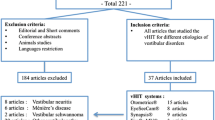Abstract
Objectives
The aim of the study was to assess the function of semicircular canal in videonystagmography head impulse test (VHIT) in the patients with vertigo and balance disorders.
Material and Methods
The study was performed in 135 patients (86 women and 49 men) aged 22–79 years, who were divided into 2 groups: I (study group) — 73 patients with vertigo of peripheral, central or mixed origin, II (control group) — 62 patients without vertigo (healthy individuals). The function of canal was determined on the basis of GAIN and expressed as DG/RH×100% (where DG is deviation of gaze and RH is rotation of head).
Results
In the study group the semicircular canal injuries were found in 37 (50.69%) patients, including 24 (32.87%) patients with 1 injury and 13 (17.8%) patients with 2 or more injuries in semicircular canal. The injured anterior semicircular canal was reported 13 times; the lateral — 9 times and the posterior — 31 times.
Conclusions
In the study group, in the VHIT, injuries in semicircular canals were reported in peripheral vertigo, mixed vertigo with non-compensated and compensated function of the labyrinth in 50.68% cases, whereas in the caloric test dysfunction of the labyrinth was found in 58.49% cases.
Similar content being viewed by others
References
Pierchała K, Janczewski G. [Vertigo]. Warszawa: Oinpharma; 2008. Polish.
Kaźmierczak H. [Selected neurootological procedures in vertigo cases]. Pol Merk Lek. 2005;19(111):459–460. Polish.
Labuguen RH. Initial evaluation of vertigo. Am Fam Physician. 2006;73(2):244–251.
Obrębowski A, editor. [Standards in diagnosis and treatment of vertigo]. Warszawa: Oinpharma; 2010. Polish.
Yin M, Ishikawa K, Wong H, Shibata Y. A clinical epidemiological study in 2169 patients with vertigo. Auris Nasus Larynx. 2009;36:30–35, http://dx.doi.org/10.1016/j.anl.2008.03.006.
Armato E, Ferri E. Results of videonystagmographic (vng) analysis in vestibular post-traumatic pathology. Acta Otorrinolaringol Esp. 2001;52(7):567–574, http://dx.doi.org/10.1016/S0001-6519(01)78251-9.
Casse G, Sauvage JP, Adenis JP, Robert PY. Videonystagmography to assess blinking. Graefes Arch Clin Exp Ophthalmol. 2007;245(12):1789–1796, http://dx.doi.org/10.1007/s00417-007-0611-8.
Weber KP, Aw ST, Todd MJ, McGarvie LA, Curthoys IS, Halmagyyi GM. Head impulse test in unilateral vestibularis loss: Vestibule-ocular reflex and catch-up saccades. Neurology. 2008;70(6):454–463, http://dx.doi.org/10.1212/01.wnl.0000299117.48935.2e.
Pietkiewicz P, Pepaś R, Sułkowski WJ, Zielińska-Bliźniewska H, Olszewski J. Electronystagmography versus videonystagmography in diagnosis of vertigo. Int J Occup Med Environ Health. 2012;25:247–256, http://dx.doi.org/10.2478/s13382-012-0002-1.
Chen CHW, Young YH, Wu ChH. Vestibular neuritis: Three-dimensional videonystagmography and vestibular evoked myogenic potential results. Acta Otolaryngol. 2000;120:845–848, http://dx.doi.org/10.1080/000164800750061705.
Halmagyi GM, Curthoys IS. A clinical sign of canal paresis. Arch Neurol. 1988;45(7):737–739, http://dx.doi.org/10.1001/archneur.1988.00520310043015.
Majak J, Olszewski J, Pietkiewicz P, Kaczorowska B. [Diagnostic evaluation of the neck rotation in cervical vertigo]. Otorynolaryngol Przegl Klin. 2006;5(1):46–50. Polish.
Pepaś R, Pietkiewicz P, Olszewski J. [Comparative analysis of nystagmus caloric test results with the use of ENG and VNG in healthy subjects]. Aktualn Neurol. 2010;10(1): 51–54. Polish.
Yagi T. Nystagmus as a sign of labyrinthine disorders three-dimensional analysis of nystagmus. Clin Exp Otorhinolaryngol. 2008;1(2):63–74, http://dx.doi.org/10.3342/ceo.2008.1.2.63.
Aw ST, Fetter M, Cremer PD, Kalberg M, Halmagyi GM. Individual semicircular canal function in superior and interior vestibular neuritis. Arch Neurol. 2001;57(5):768–774, http://dx.doi.org/10.1212/WNL.57.5.768.
Sułkowski WJ, Kowalska S, Matyja W, Guzek W, Szymczak W, Kostrzewski P. Effects of occupational exposure to a mixture of solvents on the inner ear: A field study. Int J Occup Med Environ Health. 2002;15:247–256.
Olszewski J, Pietkiewicz P, Miłoński J, Bielińska M. [The use of VHIT (Videonystagmography Head Impulse Test) in diagnostics of semicircular canals injuries]. Otolaryng Pol. 2010;64(7):32–35, http://dx.doi.org/10.1016/S0030-6657(10)70006-8. Polish.
Author information
Authors and Affiliations
Corresponding author
About this article
Cite this article
Miłoński, J., Pietkiewicz, P., Bielińska, M. et al. The use of videonystagmography head impulse test (VHIT) in the diagnostics of semicircular canal injuries in patients with vertigo. IJOMEH 27, 583–590 (2014). https://doi.org/10.2478/s13382-014-0278-4
Received:
Accepted:
Published:
Issue Date:
DOI: https://doi.org/10.2478/s13382-014-0278-4




